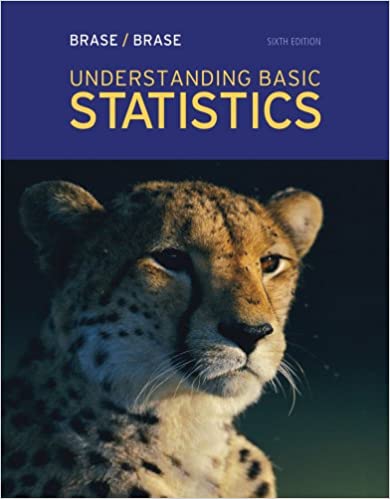
Understanding Basic Statistics 6th Edition by Charles Henry Brase,Corrinne Pellillo Brase
Edition 6ISBN: 978-1111827021
Understanding Basic Statistics 6th Edition by Charles Henry Brase,Corrinne Pellillo Brase
Edition 6ISBN: 978-1111827021 Exercise 3
Please provide the following information for Problems 11-22, part (a):
(i) What is the level of significance State the null and alternate hypotheses.
(ii) Check Requirements What sampling distribution will you use What assumptions are you making What is the value of the sample test statistic
(iii) Find (or estimate) the P -value. Sketch the sampling distribution and show the area corresponding to the P -value.
(iv) Based on your answers in parts (i) - (iii), will you reject or fail to reject the null hypothesis Are the data statistically significant at level a
(v) Interpret your conclusion in the context of the application.
Note: For degrees of freedom d.f. not in the Student's t table, use the closest d.f. that is smaller. In some situations, this choice of d.f. may increase the P -value a small amount, and therefore produce a slightly more "conservative" answer.
Answers may vary due to rounding.
Education: Tutoring In the journal American Journal on Intellectual and Developmental Disabilities , an article reported the results of a peer tutoring program to help mildly mentally retarded children learn to read. In the experiment, the mildly retarded children were randomly divided into two groups: The experimental group received peer tutoring along with regular instruction, and the control group received regular instruction with no peer tutoring. There were n 1 = n 2 = 30 children in each group. The Gates-MacGintie Reading Test was given to both groups before instruction began. For the experimental group, the mean score on the vocabulary portion of the test was
 with sample standard deviation s 1 = 49.1. For the control group, the mean score on the same test was
with sample standard deviation s 1 = 49.1. For the control group, the mean score on the same test was
 with sample standard deviation s 2 = 50.9.
with sample standard deviation s 2 = 50.9.
(a) Use a 5% level of significance to test the hypothesis that there was no difference in the vocabulary scores of the two groups before the instruction began.
(b) Find a 95% confidence interval for 1 2. Explain the meaning of the confidence interval in the context of the problem.
(i) What is the level of significance State the null and alternate hypotheses.
(ii) Check Requirements What sampling distribution will you use What assumptions are you making What is the value of the sample test statistic
(iii) Find (or estimate) the P -value. Sketch the sampling distribution and show the area corresponding to the P -value.
(iv) Based on your answers in parts (i) - (iii), will you reject or fail to reject the null hypothesis Are the data statistically significant at level a
(v) Interpret your conclusion in the context of the application.
Note: For degrees of freedom d.f. not in the Student's t table, use the closest d.f. that is smaller. In some situations, this choice of d.f. may increase the P -value a small amount, and therefore produce a slightly more "conservative" answer.
Answers may vary due to rounding.
Education: Tutoring In the journal American Journal on Intellectual and Developmental Disabilities , an article reported the results of a peer tutoring program to help mildly mentally retarded children learn to read. In the experiment, the mildly retarded children were randomly divided into two groups: The experimental group received peer tutoring along with regular instruction, and the control group received regular instruction with no peer tutoring. There were n 1 = n 2 = 30 children in each group. The Gates-MacGintie Reading Test was given to both groups before instruction began. For the experimental group, the mean score on the vocabulary portion of the test was
 with sample standard deviation s 1 = 49.1. For the control group, the mean score on the same test was
with sample standard deviation s 1 = 49.1. For the control group, the mean score on the same test was  with sample standard deviation s 2 = 50.9.
with sample standard deviation s 2 = 50.9.(a) Use a 5% level of significance to test the hypothesis that there was no difference in the vocabulary scores of the two groups before the instruction began.
(b) Find a 95% confidence interval for 1 2. Explain the meaning of the confidence interval in the context of the problem.
Explanation
(a)-(i)
Let
and
be the means of th...
Understanding Basic Statistics 6th Edition by Charles Henry Brase,Corrinne Pellillo Brase
Why don’t you like this exercise?
Other Minimum 8 character and maximum 255 character
Character 255


